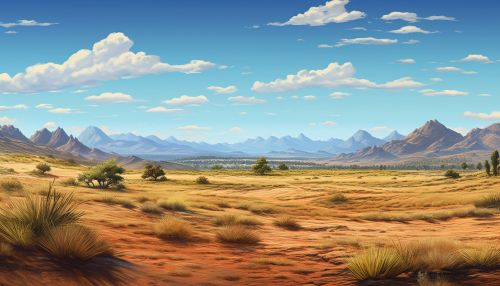Mojave Desert
Geography
The Mojave Desert is a vast arid region in the southwestern United States, extending across parts of California, Nevada, Utah, and Arizona. It is bounded by the Great Basin Desert to the north and the Sonoran Desert to the south and east. The Mojave Desert's western boundary is generally considered to be the San Gabriel and San Bernardino mountain ranges in California. The desert's total area is approximately 47,877 square miles (124,000 square kilometers), making it the smallest desert in North America.


Climate
The Mojave Desert is characterized by its hot, dry climate. It is classified as a "rain shadow" desert, meaning it is sheltered from precipitation by mountain ranges. The average annual rainfall in the Mojave is less than six inches (15 cm), with the majority of precipitation occurring in the winter months. Summers in the Mojave are extremely hot, with temperatures often exceeding 120 degrees Fahrenheit (49 degrees Celsius). Winters, on the other hand, can be quite cold, with temperatures frequently dropping below freezing.
Flora and Fauna
Despite its harsh climate, the Mojave Desert is home to a diverse array of plant and animal species. The desert's most iconic plant is the Joshua Tree, which is endemic to the Mojave. Other common plant species include the Mojave yucca, creosote bush, and various types of cacti.
Animal life in the Mojave is equally diverse, with species adapted to survive in the desert's extreme conditions. Mammals such as the desert bighorn sheep, coyote, and black-tailed jackrabbit are common, as are reptiles like the desert tortoise and Mojave rattlesnake. The desert is also home to over 200 species of birds, including the roadrunner and the golden eagle.
Human History and Settlement
The Mojave Desert has been inhabited by humans for thousands of years. The earliest known inhabitants were the Paiute, Mohave, and Chemehuevi peoples, who lived in the region as early as 10,000 years ago. These groups were hunter-gatherers who adapted to the desert environment by developing sophisticated knowledge of local plant and animal resources.
In the 19th century, the Mojave became a significant route for westward expansion in the United States. The Old Spanish Trail, a trade route connecting Santa Fe to Los Angeles, passed through the Mojave, as did later routes such as the Mormon Trail and the Route 66.
Today, the Mojave Desert is home to several large cities, including Las Vegas, Nevada, and Lancaster, California. The desert is also the site of numerous military installations, including the Naval Air Weapons Station China Lake and the Nellis Air Force Base.
Conservation and Environmental Issues
Conservation efforts in the Mojave Desert are primarily focused on protecting the desert's unique ecosystems and biodiversity. The Mojave National Preserve, established in 1994, is a large protected area in the heart of the desert that aims to preserve the region's natural and cultural resources.
However, the Mojave faces several environmental challenges. Climate change is a significant concern, as rising temperatures and changing precipitation patterns threaten the desert's delicate ecosystems. Other issues include habitat destruction due to urban development, invasive species, and pollution from mining and military activities.
